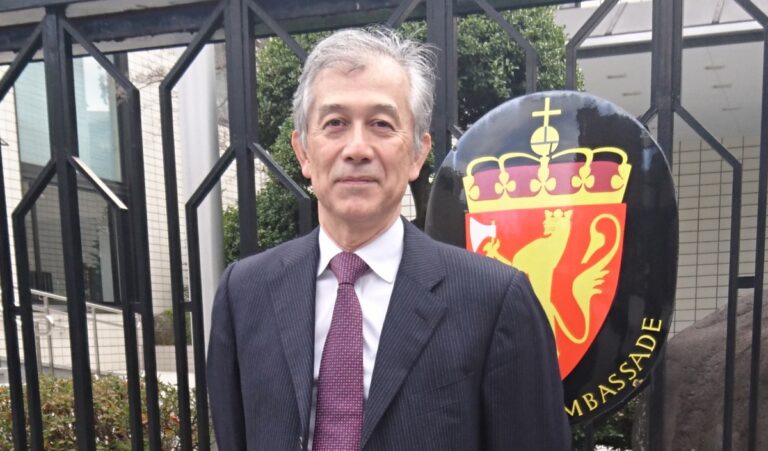Since April, Hiroshito Matsumoto has worked from a base in Toyko on behalf of NTNU and the University of Bergen to build new research partnerships between Japan and Norway.
This article was originally published on GEMINI, which publishes up-to-date research news from the Norwegian University of Science and Technology, Norway’s main science and engineering university, and SINTEF, Scandinavia’s largest independent research group.

For a good part of his professional career, Hiroshi Matsumoto has worked with plasma physics and its practical application in developing nuclear reactors that use fusion.
Plasma is the fourth state of matter, the ionized gas that makes up the Sun and that allows it to produce the tremendous amounts of energy that we perceive as the Sun’s light.
Starting April 1, Matsumoto will take up a new job that he also hopes will release a tremendous amount of energy, when he begins working with NTNU and the University of Bergen to build research partnerships between Norway and Japan.
“I am really motivated to take up this position,” Matsumoto said in mid-March, when he was in France visiting one of his former employers, ITER, the international project whose goal is to create energy from nuclear fusion. “There is huge potential here. I am ready to work to build good research collaborations between Norway and Japan.”
NTNU Rector Gunnar Bovim says that NTNU and Norway will benefit greatly from building partnerships with Japan, in part because the island nation is also extremely interested in marine resources and renewable energy, two areas that are also quite important to Norway.

“I believe Mr. Matsumoto’s qualifications and enthusiasm for the job will help researchers from our two countries build strong and productive academic and industrial partnerships that will create knowledge the world needs now,” Bovim said. “Both Japanese universities and industries are of a very high quality, and there are a lot of disciplines where we see we can work together.”
An international career
Matsumoto, 63, has a PhD in engineering from the University of Tokyo, but took his master’s degree from the University of Wisconsin in the United States in engineering and physics.
His lengthy career, which began in 1979 at the Japan Atomic Energy Research Institute, led him to positions in the US and France in addition to Japan. While much of his work has been specifically focused on plasma physics and nuclear fusion, his experience also includes engineering integration and project management, working with international research projects.
Most recently, he has served as the Horizon 2020 National Contact Point Coordinator in Japan. Svein Grandum, Counsellor, science, technology and higher education for Innovation Norway’s Japan office, says Matsumoto has a deep cross-cultural understanding of the workings of both the Japanese and the European systems.
“He has worked in Europe for many years and he knows the system,” Grandum said.
Matsumoto will actually be employed by the Trade and Technology Office of Innovation Norway in Tokyo, which is part of the Norwegian Embassy, but will work on behalf of both NTNU and the University of Bergen.
Renewable energy important
Nuclear power has long been important to Japan, which has generated as much as 30 per cent of its electricity from nuclear reactors. But the Fukushima Daiichi nuclear accident in March, 2011, has changed all that.
Now, renewable energy has a much stronger appeal in Japan, Matsumoto said, which is one reason he is enthusiastic about working with NTNU to build research partnerships.
“I am really convinced that offshore wind is the way for the Japanese people this century,” he said, adding that offshore wind is one area where both NTNU and Norway have a great deal of expertise.
One important difference between Japanese and Norwegian universities is that “Japan has many good researchers doing basic research, but not that many researchers have been motivated to connect their research to the needs of society,” Matsumoto said.
In contrast, Norwegian research tends to be more practical and applied, which will benefit Japanese researchers, he said.
“There is huge potential for the future,” he said.
Upstream, downstream, complementary expertise
Norway and Japan complement each other in many other ways, Grandum said. Japan, like Norway, is interested in addressing global challenges, such as climate change, and as an island nation, marine and maritime issues are of critical importance to the country, he said.
Norway’s approach to these different issues is part of the reason that research partnerships between the two countries have such enormous potential, Grandum said.
“The energy scheme is a good example of our complementarity,” he said. “We are more upstream, they are more downstream: We produce oil and gas, we have strong competence in hydropower and power systems, solar and wind, while in Japan they have a lot of expertise on the downstream, user end side, where their industry has strong involvement, and in how best to get the most out of energy for the end user.”
Working with cultural differences, internationalization
Grandum said that one surprise for Norwegians coming to Japan would be the difference in how research and business projects proceed. This is one area where Matsumoto’s help will be invaluable, he said.
“The Japanese plan and plan,” he said. “And then they execute things very quickly. That is one of the real challenges for Norwegians coming here. Norwegians just want to get started and adjust while they go.”
Grandum himself has some familiarity with this situation, since he has lived in Japan a total of 17 years and took his PhD in materials science from the University of Tsukuba.
Another goal is to increase the number of exchanges between the two countries, said Nina Sindre, NTNU’s coordinator of international affairs. “We see a great deal of potential when it comes to research, co-publication and researcher, PhD and postdoctoral mobility,” she said.
Building stronger contacts between NTNU and different Japanese universities could help increase that number by allowing NTNU researchers to learn more about relevant offerings in Japan, she said.
For his part, Matsumoto says that his own experience living in different cultures gives him strong motivation to promote internationalization for both Norway and Japan.
“I see many possibilities,” he said. “I look forward to finding the best combinations with (Norwegian) and Japanese research groups, and I am personally very motivated to do this.”

